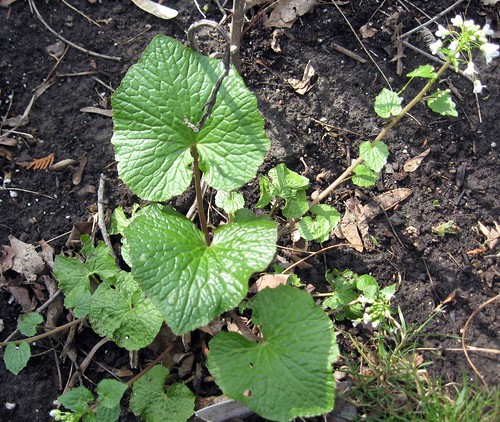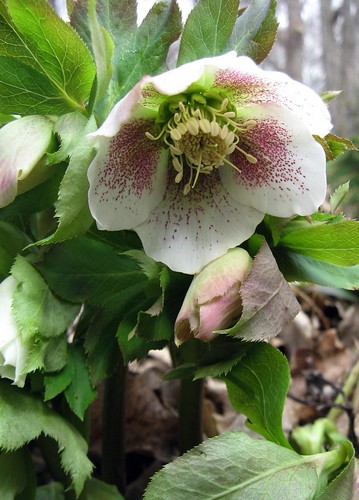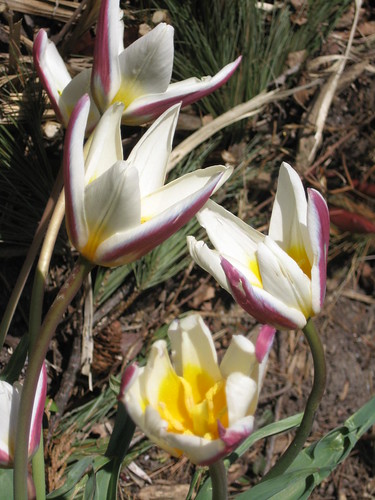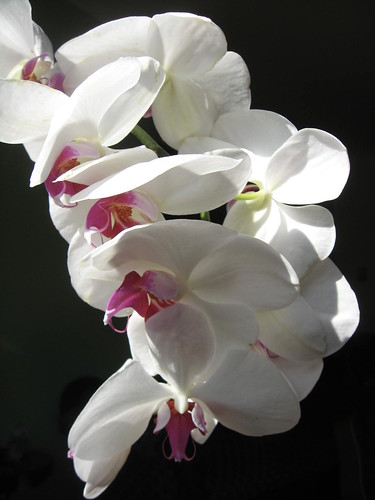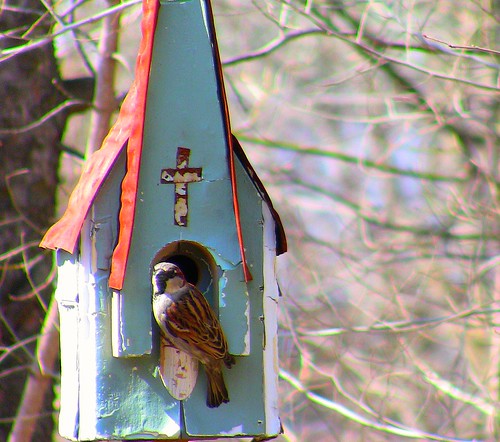So green when the sun comes out...
Thursday, April 30, 2009
Wednesday, April 29, 2009
Wasabi
I planted this wasabi last spring, thinking I was foolish to believe it could over-winter. But here it is! By fall I should be able to harvest the root.... In the meantime I can enjoy the foliage while I hunt for a suitable recipe. The plant will likely get about 3 feet tall during the season. I can't believe the bugs have been at it already... hopefully it is too hot for their taste and they will leave it alone over the next few months!
Monday, April 27, 2009
We All Share the Same Backyard

 "We all share the same backyard."
"We all share the same backyard."I didn't expect to go to this year's Ontario Horticultural Society AGM and come away an advocate for shade grown, organic, fair trade coffee, but that's what happened Saturday.
 Nicki and I went to listen to the speakers and pick up some horticultural tips. One of the presenters spoke about Project Chirp, (Creating Habitat In Residential areas and Parkland) a songbird conservation initiative in which the survival needs of songbirds are met through the creation of Canadian Wildlife Federation-certified songbird habitats on residential properties. Lots of great tips for using trees and shrubs to create a welcoming habitat for songbirds and pollinators. One of my favourite things about my backyard are the birds that happen by, like the finches at our feeder on the right.
Nicki and I went to listen to the speakers and pick up some horticultural tips. One of the presenters spoke about Project Chirp, (Creating Habitat In Residential areas and Parkland) a songbird conservation initiative in which the survival needs of songbirds are met through the creation of Canadian Wildlife Federation-certified songbird habitats on residential properties. Lots of great tips for using trees and shrubs to create a welcoming habitat for songbirds and pollinators. One of my favourite things about my backyard are the birds that happen by, like the finches at our feeder on the right.Toronto is on the major migration route of several species. With so much of the green space on our planet shrinking it is getting tougher and tougher for many of these birds to make their journey.
Much of the boreal and rainforest is disappearing to fuel consumer demand for new 'stuff'. Which is why the personal choices we make are more important than ever.

Which brings me to the coffee. These plantations clear-cut rainforest to make way for profitable cash crops and destroy habitat in the process. The environment is thrown off balance. The bird population decreases, the insect population increases, more pesticides are used and remaining wildlife is poisoned. The impact of large-scale operations on local economies is brutal as well. Shade grown labels mean trees remain for habitat. Organic farming methods mean the food is better for your body, but it's also better for the environment as well. Fair trade practices cut out the middle man and help ensure people are paid fairly for their labour.
 Another choice I'll make in the future is to buy 100% recycled paper and paper labelled 'fsc' when possible. To earn the Forest Certified Council certification companies must also involve local communities and Aboriginal Peoples in the development of forest management plans, and respect their rights and beliefs. FSC is the only forest certification standard supported by organizations such as the World Wildlife Fund of Canada, Sierra Club of Canada and Greenpeace.
Another choice I'll make in the future is to buy 100% recycled paper and paper labelled 'fsc' when possible. To earn the Forest Certified Council certification companies must also involve local communities and Aboriginal Peoples in the development of forest management plans, and respect their rights and beliefs. FSC is the only forest certification standard supported by organizations such as the World Wildlife Fund of Canada, Sierra Club of Canada and Greenpeace.You can sign this petition to 'Save Our Boreal Birds' online
or visit the Canadian Wildlife Federation website Wild About Gardening for tips on badkyard habitat creation and certification.
Friday, April 24, 2009
Stickleback
 What I find intriguing about this wine is the mix of grapes: Cabernet Sauvignon, (that, I know I like), some shiraz (please not too much!), Dolcetto (new varietal for me) and Granache. Wonderful blend.
What I find intriguing about this wine is the mix of grapes: Cabernet Sauvignon, (that, I know I like), some shiraz (please not too much!), Dolcetto (new varietal for me) and Granache. Wonderful blend.'Red' wine with a screw top cap from Southern Australia, $15 at the LCBO. The great label might catch your eye but then you might think, screw top? red? ..... and pass it by.
The label promises 'soft, round, spicy' but I don't entirely agree.
Lovely colour in the glass (muted garnet?), spicy aroma, lively & great taste, mouth feel is brash but invigorating, a long finish. I wouldn't call this one 'soft' at all. As for 'round' isn't that meant to mean balanced? My mid-tongue is reverberating (a not unpleasant sensation, just not what I would call 'balanced'). Highly acidic and highly tannin and fairly sweet.
I like everything about it but the finish, which seems artificially long-lasting and turns bitter on the tongue.
I think I would buy this again but definitely serve it with dinner or tapas.
Wednesday, April 22, 2009
Lenten Rose
What the hellabore is that?
(A memory trick for me, kept referring to this plant as a huchera).
Tuesday, April 21, 2009
The Last Waltz
 The Last Waltz. 1978. Was it really 31 years ago? The Scorcese film captures great moments and feels entirely fresh.
The Last Waltz. 1978. Was it really 31 years ago? The Scorcese film captures great moments and feels entirely fresh.To tell the truth it has never held my interest for more than a few songs on a television screen, but Rob and I went to see it tonight at the Fox theatre and it was incredibly moving. You just need to see some things on 'the big screen.'
The original group (1967-1976) consisted of four Canadians: Robbie Robertson (guitar, piano, vocals); Richard Manuel (piano, harmonica, drums, saxophone, organ, vocals); Garth Hudson (organ, piano, clavinet, accordion, synthesizer, saxophone); and Rick Danko (bass guitar, violin, trombone, vocals), and one American, Levon Helm (drums, mandolin, guitar, bass guitar, vocals). I didn't realize it but the members of the Band first came together as they joined rockabilly singer Ronnie Hawkins' backing group, The Hawks, one by one between 1958 and 1963.
The film captures great music and live performances, intercut with insightful interviews featuring different members of the Band.
Amazing musicians — Bob Dylan, Neil Young, Neil Diamond, Joni Mitchell, Eric Clapton, Emmylou Harris, Van Morrison, Muddy Waters, Ringo Starr, Ron Wood — appear in the film to help celebrate the Band's last performance, after 16 years of touring together on the road.
The scene of Bob Dylan and Robbie Robertson playing Forever Young — the words and the music — an indelible moment.
Here are the lyrics... enjoy!
Forever Young
May God bless and keep you always
May your wishes all come true
May you always do for others
And let others do for youMay you build a ladder to the stars
And climb on every rung
May you stay forever young
Forever young, forever young
May you stay forever young.
May you grow up to be righteous
May you grow up to be true
Forever Young
May God bless and keep you always
May your wishes all come true
May you always do for others
And let others do for you
May you build a ladder to the stars
And climb on every rung
May you stay forever young
Forever young, forever young
May you stay forever young.
May you grow up to be righteous
May you grow up to be true
May you always know the truth
And see the lights surrounding you
May you always be courageousStand upright and be strong
May you stay forever young
Forever young, forever young
May you stay forever young.
May your hands always be busy
May your feet always be swift
May you have a strong foundation
When the winds of changes shift
May your heart always be joyful
And may your song always be sung
May you stay forever young
Forever young, forever young
May you stay forever young.
May you always know the truth
And see the lights surrounding you
May you always be courageous
Stand upright and be strong
May you stay forever young
Forever young, forever young
May you stay forever young.
May your hands always be busy
May your feet always be swift
May you have a strong foundation
When the winds of changes shift
May your heart always be joyful
And may your song always be sung
May you stay forever young
Forever young, forever young
May you stay forever young.
Sunday, April 19, 2009
Friday, April 17, 2009
Orchid
Do you think this orchid is aware on some level that it is amazing and beautiful and inspiring? Is it even aware of itself? If not, is its "unexamined life" worth living?
Thursday, April 16, 2009
Fanny Howe

Fanny Howe has been announced as the winner of the $100,000 Ruth Lilly Poetry Prize for lifetime achievement.
How exciting! I've been reading from her collection, Selected Poems for the past two weeks! I heard an interview with her via podcast at the Poetry Foundation and had to go out and get her book after hearing her voice.
In a 2004 interview with the Kenyon Review, Howe said this about her work: "If someone is alone reading my poems, I hope it would be like reading someone's notebook. A record. Of a place, beauty, difficulty. A familiar daily struggle."
Here are some favourites from that book...
*
I won't be able to write from the grave
so let me tell you what I love:
oil, vinegar, salt, lettuce, brown bread, butter,
cheese and wine, a windy day, a fireplace,
the children nearby, poems and songs,
a friend sleeping in my bed —
and the short northern nights.
*
Moon ink is too bright to read.
You run your fingers over the print
and get some sense.
But then you lose it too.
It swims in a pool of logic
that you can't disprove
because it doesn't move.
*
Into the forest I went walking — to get lost.
I saw faces in the knots
of trees, it was insane, and hands
in branches, and everywhere names.
Throughout the elms
small birds shivered and sang
in rhyme.
I wanted to be air, or wind — to be at ease
in outer space but in the world
this was the case:
Human was God's secret name.
*
Monday, April 13, 2009
Chickpea
 The way Mark Bittman described this Street Treat from Nice I just had to try it for myself :
The way Mark Bittman described this Street Treat from Nice I just had to try it for myself :...its main attractions are these: The batter is quicker to put together than pancake batter; it can rest for an hour or even half a day, or not; it is baked in a normal oven, finished in a broiler and done in about 20 minutes; it's served hot or warm, to be eaten with the fingers. And it's irresistible.

For me its other virtue is that is is cooked in a cast iron pan, one of my all-time kitchen favourites.
I tried it and he's right - it is absolutely irresistible. A quick comfort food that I think will become part of our regular menu.
Socca/Farinata Published: October 19, 2005
Time: 45 minutes
1. Heat oven to 450 degrees. Put a well-seasoned or nonstick 12-inch pizza pan or cast-iron skillet in oven. Sift chickpea flour into a bowl; add salt and pepper; then slowly add 1 cup lukewarm water, whisking to eliminate lumps. Stir in 2 tablespoons olive oil. Cover, and let sit while oven heats, or as long as 12 hours. Batter should be about the consistency of heavy cream.
2. If using onion and rosemary, stir them into batter. Pour 2 tablespoons oil into heated pan, and swirl to cover pan evenly. Pour in batter, and bake 12 to 15 minutes, or until pancake is firm and edges set. Heat broiler, and brush top of socca with 1 or 2 tablespoons of oil if it looks dry.
3. Set socca a few inches away from broiler for a few minutes, just long enough to brown it spottily. Cut it into wedges, and serve hot, or at least warm.
Yield: 4 to 6 appetizer servings.
 It went "nicely" with these chick pea 'burgers.'
It went "nicely" with these chick pea 'burgers.'Chickpea burgers from Real Simple magazine
1 15.5-ounce can chickpeas, rinsed
1/2 cup fresh flat-leaf parsley
1 clove garlic,
chopped 1/4 teaspoon ground cumin
Kosher salt and black pepper
2 tablespoons all-purpose flour
2 tablespoons olive oil
1/2 cup low-fat yogurt (preferably Greek)
3 tablespoons fresh lemon juice
8 cups mixed greens
1 cup grape tomatoes 1/2 small red onion,
thinly sliced Pita chips (optional)
1 In a food processor, pulse the chickpeas, parsley, garlic, cumin, and 1/4 teaspoon each salt and pepper just until coarsely chopped and the mixture comes together when gently squeezed. Form into eight 1/2-inch-thick patties and coat with the flour, tapping off excess.
2 Heat the oil in a nonstick skillet over medium-high heat. Cook the patties, turning carefully, until golden brown, 2 to 3 minutes per side.
Sunday, April 12, 2009
Thursday, April 9, 2009
Snowdrops

Snowdrops, originally uploaded by Things We Love.
I know it is hard to see - but see the bee? just in the bottom left, resting on the leaf.
Wednesday, April 8, 2009
Weeping Moon - April
 The April Full Moon is sometimes known as Rainy Moon and Weeping Moon...
The April Full Moon is sometimes known as Rainy Moon and Weeping Moon...According to the Farmer's Almanac it is known by other names as well:
- The name "Full Pink Moon," which came from the herb moss pink, or wild ground phlox, which is one of the earliest widespread flowers of the spring.
- Other names for this month's celestial body include the Full Sprouting Grass Moon, the Egg Moon, and among coastal tribes the Full Fish Moon, because this was the time that the shad swam upstream to spawn.
... The Almanac moon references seem to suit a warmer climate than chilly Toronto! The Rain Moon and Weeping Moon seem more suitable for our coordinates....
Here is a haiku from a fellow blogger at 'Full Moon of November'
beneath a sparrow's flutter
april snow
Full Pink Moon - Full Sprouting Grass Moon - Egg Moon - Full Fish Moon - April Moon, originally uploaded by Michael Brenton.
Tuesday, April 7, 2009
Yoga Conference IV — Balance and Experience
 Insights Into Balance
Insights Into BalanceI enjoyed the geeky perspective Blake Martin, the neuroscientist/yoga enthusiast brought to his class by breaking down the mathematical equation for balance, sharing the results of controlled studies on balance, and then having people play around a bit to see how these principles could be applied practically inside poses. It is one thing rationally knowing that the lower the point of balance, the steadier the structure. It is another thing to experience it.
Taking his class the night before Rodney Yee/Colleen Saidman co-taught 'understanding sacrum,' was a great segway. When they started talking about using the sacrum as a point of focus it made sense from a physiological standpoint. Shifting focus to this area away from head/neck/chest effectively lowers your point of reference and brings a sense of groundedness to the poses. We weren't isolating the sacrum though, we were flowing through basic sequences and feeling the connectedness shift as relationships shifted within the body. A very fluid feeling. Languorous. Luxurious.
Yee was pushing people to go past the point of balance in Half Moon pose until they fell over. The rationale being that people don't reach the perfect point of balance, they usually stop a bit short. By stopping short they never reach the point of perfect balance. So fall already! I found this instruction one of the more difficult to follow.

In Natasha's class I got some tips for improving crow pose, but I definitely need to improve my arm strength if I am going to hold it longer than 3 or 4 breaths!
Some interesting facts from Blake's class:
- postural reflexes turn off when you are leaning on a support, so doing headstand or handstand against the wall may train strength and alignment, but it doesn't teach balance
- what your feet feel on the mat is more important than a visual cue (people held poses longer if they were blindfolded but were receiving reliable info in their feet vs. if they had unreliable info in their feet but were not wearing blindfolds)
- drishdi/gaze is important in balance... in handstand it is about 5 cm in front of your hand... hands are much less s
 ensitive than feet in reading balance, and eyes-open handstands last longer (even when done by professional acrobats)
ensitive than feet in reading balance, and eyes-open handstands last longer (even when done by professional acrobats)- most successful handstands have lower torques at the wrist (get this effect by locking elbows)
- when your head is in a dorsiflexed position (see photo at left) balance is improved
- people often kick up against a wall to get into handstand, this technique doesn't work when the wall isn't there because momentum will carry you past the point of balance (so don't teach yourself how to get into headstand this way!)
The Value of Experience
Taking a class with an experienced teacher gives you feedback you don't get when you are reading a magazine or following along with a DVD. In the end you don't learn about yoga only by reading or listening. You learn by doing, experiencing and feeling; by being present. A teacher can't really do this on your behalf, but they can certainly open the door. Experiencing the same poses in new ways and from different disciplines was extremely valuable. Having access to so many unique teachers in such a condensed period of time was truly inspiring. Mind bending in the best of all senses.
Monday, April 6, 2009
Yoga Conference III — Daily Practise

The Importance of Daily Practise
It isn't disputed that a regular daily physical discipline can build and maintain strength and flexibility; spike endorphins to improve your mood; increase mental agility and focus.
Daily practise is also important because:
- Recent studies show that yoga and meditation also improve brain plasticity, something essential to mental functioning, especially as we age. Studies of Tibetan monks have discovered that their brains actually produce theta waves when they meditate, which is a whole different level of brain activity. The theory is you need about 5000 lifetime hours to reach that level (Martin).
- The fact is that even 15 minutes of meditation a day is shown to reduce the chemical cortisol in the body, which can be extremely toxic over time. (Sovik).
- A regular practise will yield immediate short-term benefits but has the potential to being life-changing as well. The goal doesn't necessarily need to be to wrap your feet over and behind your head. A Level One practise of basic postures, done consistently, has the same health benefits as a more rigorous routine (Rizopoulis).
- Just don't approach the same poses in the same way day after day; bring a state of mindfulness to every pose. Even if you are doing the same sequence, approach it in a fresh way. Be playful and lighthearted, have fun. Explore different connections. Try using the sacrum as a central point of focus. Shake things up. Iyengar says he is still learning something new every day (Yee).
Technical tips to keep in mind
- Don't worry so much about the eyes of the elbows when in plank or downward dog. Notice instead that the creases of your wrists are in line with the front of the mat and that you keep shoulders out. Let the eyes of the elbow fall into a natural alignment.
- In arm balances, keep the external rotation of the arms at all times or r
 isk shoulder damage.
isk shoulder damage.- In the Sun Salutations, do chaturanga instead of knees/chest/chin because chaturanga is kinder to the shoulders. Don't dip below the point of the elbows. It requires and builds more strength to do chaturanga this way. When coming out of chaturanga you know if you are doing it correctly if pelvis, then belly, then lower ribs touch the ground.
- You can improve alignment in chaturanga by making a belt into a hammock, placed between your arms at the point of the elbows. At the same time you are doing this press your feet into a wall behind you. Imprint the feeling of these actions into the pose when you do it 'prop-free.'
- Go more deeply into forward bends by firming your quads at the front of your thighs and letting go of your hamstrings in the back of your thighs.
- Here is Natasha behind the scenes at a Yoga Journal shoot demonstrating the correct position for chaturanga. Apparently there was quite a debate about proper alignment between the different advocates for the different styles of yoga.
- Yee recommends to feel the cow/cat undulation all the way through Sun Salutations, and try doing the entire sequence from the sacrum, not from the head and neck.
- Try kicking up from Dog Pose into Hand Stand. Just for fun.
Practical approach to meditation
Remember to keep knees lower than hips. I was sitting in virasana, which is fine, but Sovik recommended I switch my wooden block for a pillow that might be kinder on my sit bones. Arms placed in a comfortable position, near the centre of the body rather than picturesquely rested on the knee will likewise be easier to maintain over a long period of time. Neck in line with shoulders, chin very slightly down.
A great beginner mantra is So-Hum. 'So' on the inhalation and 'Hum' on the exhalation. There is much to contemplate in these two syllables, with the basic meaning of "I am. That."
Try to assume a mental attitude that does not grasp too tightly or too loosely. Don't be too attached to the outcome.
Inhale. Pause. Exhale. Pause.
Saidman mentioned the pause just after the exhalation has extraordinary potential to bring a feeling of peace and ease.... and it is open to you thousands of times every day...
Sunday, April 5, 2009
Yoga Conference II — A Full Itinerary
 A very busy itinerary at the yoga conference brought some interesting insights.
A very busy itinerary at the yoga conference brought some interesting insights.Spent the day Friday at a workshop that explored the idea of balancing effort with ease and strength with flexibility (or 'sthira sukham asanam' according to the Patanali sutra). The entire six hours was spent breaking down the poses in the classical ashtanga sun salutations. The teacher, Natasha Rizopoulos, is a regular contributor to Yoga Journal. She was an ashtanga fiend before she discovered Iyengar later in life, so she combines the two sensibilities in her teaching. Oh yes, and she also graduated magna cum laude with a degree in literature and history from Harvard.
After that class I went to one given by PHD student/neuroscientist Blake Martin about the effects of yoga on the brain and how to apply physics to your understanding of balance in your practise. Blake is also a dancer, Thai masseuse, martial artist and runner.
Later that night it was dancing with a room full of yogis, mostly women, for a full two hours. I took my sweaty body home and had a very sound sleep.
The next day it was back for a two hour class with Rodney Yee and his wife Colleen Saidman to explore the sacrum, another two hours with Natasha on arm balancing, followed by a two hour class with author and Himilayan Institute faculty member Rolf Sovik about meditation and mantra. The day ended with the Krisha Das concert.
I still kept my regular weekly yoga practice date Sunday morning. But thankfully it was a restorative class.
My brain has been humming all day. Physically spent, out of my head. What's left? If you have the answer, let me know because you may just have discovered the meaning of life!
I want to savour some of the lessons learned before I try to articulate them and reduce them to mere words.
Insights into the essential discipline of daily practice, the nature of balance, the value of experience, the importance of getting out of your head, transcending body, the meaning of connection, music as enlightenment....
So over the next few days I will try to digest it and capture bits of it in the blog for my future reference.
For now, though, this phrase to ponder - what does your daily practise serve? Your dharma or your ego?
Moving In - 2009
A pair of sparrows has moved into our backyard birdhouse and they are getting their nest ready, bringing in fresh cedar and suitable twigs. You need to be patient to catch a glimpse of their comings and goings. It was a fun Sunday morning family project to grab the photo, borrowing Alex' camera and Rob digging out the old Manfrotto legs. Setting up and then waiting. And waiting. The next door neighbour then decided it was a good time to bring out their skill saw, which I figure must be particularly terrifying to small animals. When the bird finally made its appearance I was so excited I almost forgot to snap the photo!
Yoga Conference I — Kirtan
 Two full days out of my head at a Yoga Conference! I so needed a break from being mental.
Two full days out of my head at a Yoga Conference! I so needed a break from being mental.Two full days spent pushing myself physically and then ending with a celebration of music. Tired. Soar. Blissed out.
Just came home from the Krishna Das concert. A kirtan call (sorry, couldn't resist). Kirtan is "call and response," a bhakti yoga practise that has the audience repeating what the musician is musically phrasing. Mostly in Sanskrit. What does it mean? Is not knowing the meaning of words a disadvantage? The words become music through repetition and melody. If the world can be divided into two types of people - the ones that hear melody and the ones that hear lyrics - I would be on the side of the planet that hears the melody. My brain seems to prefer it. And now that my hearing is fading it is all the more difficult to discern the meaning of the words even in English. So holding a sheet of chants printed in a foreign tongue and trying to sing along is oddly comforting. I think it is because by taking the meaning out of the words they become something else, something just as magical. Or perhaps it is because the words suddenly transcend meaning.
Later in the evening he led everyone in a rousing country kirtan of "Jesus On the Mainline... tell him what you want." It was totally fun. It seemed like the world turned upside down. It was approaching the song and words without the ingrained prejudice and bias I usually bring to lyrics like that.
Kirtan is interesting because it so much relies on interaction. The more you participate the more you enrich the experience. I was sandwiched between a very enthusiastic person and one that was far more restrained, and it was like being numb on one side of the body. Unlike going to a traditional concert, where the role of the audience is to simply clap in appreciation when the musical interlude has ended, in kirtan the demand to respond penetrates from the stage right into your skin.
Krishna Das was wearing a red plaid shirt. Born Jewish and looking pretty white, here is a clip of the Soul Man. Not what you visually expect when you hear the music, but then again maybe this is what makes it so accessible. A North American accent returning om. (oh no, I really do need to head to bed for some zzzzzz).
More on the conference later.
Saturday, April 4, 2009
Cardinal
Such brilliant plumage this time of year!
The photo is from flickr but it may well have been the same cardinal looking for a new nest.
He was scouting out my backyard - hope he moves in!
The photo above led me to this collection of cardinal photos.
Usually the males are the more spectacular, but with cardinals I think the females are just as gorgeous.
We do have a pair of sparrows nesting in the backyard birdhouse, but it has been proving to be a real challenge trying to catch a glimpse, let alone grab a photo.
I'll have to stake out some early morning with coffee and camera in hand.
When it's warmer.
By then, maybe there will be chicks...
Wednesday, April 1, 2009
Around the World in 80 Gardens
I caught my first glimpse of these amazing and extraordinary places in the BBC series 'Around the World in 80 Gardens.' The program tours green spaces all over the planet and makes you look at how individuals, culture, indigenous plants and climate combine to create unique gardens. Italy, South Africa and Mexico are stops along the way.
So far Mexico /Cuba is one of my favourite episodes, featuring the surreal paradise created by a millionaire eccentric; the floating gardens of the Amazon; and an ethno-botanical garden.
The Ethno-botanical garden, Centro Cultural de Santo Domingo, in Oaxaca (pictured above) was slated to become the site of a hotel with sections paved over to become a parking lot, but due to the efforts of locals and the dedication of an artist-turned-gardener, this beautiful space was created instead.
Take a look at this clip on You Tube about the surreal gardens created in Xilitla, Northern Mexico, by the British millionaire Edward James. The photo on the right is merely a morsal of "Las Pozas," an obsession covering more than 50 acres and costing more than $7M. The jungle is reclaiming the sculptures throughout, adding a pagan note to a Dali landscape. Or is it subtracting what is surreal and making it real again? Without constant vigilance the man-made elements will soon totally disappear. What would future archaeologists decipher this to be?

